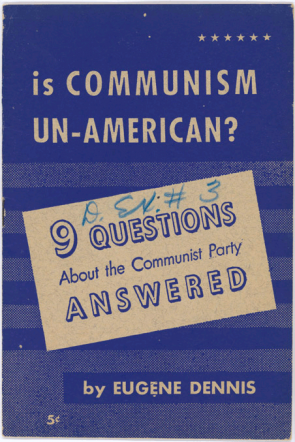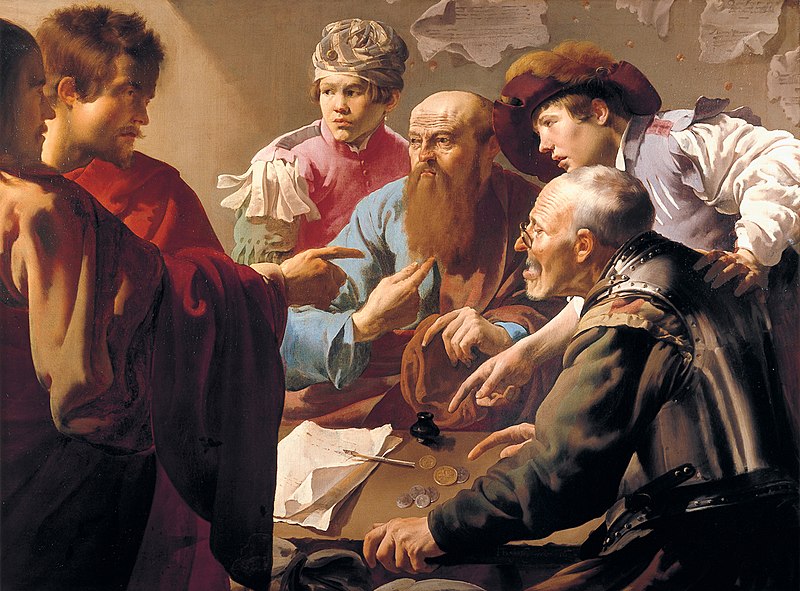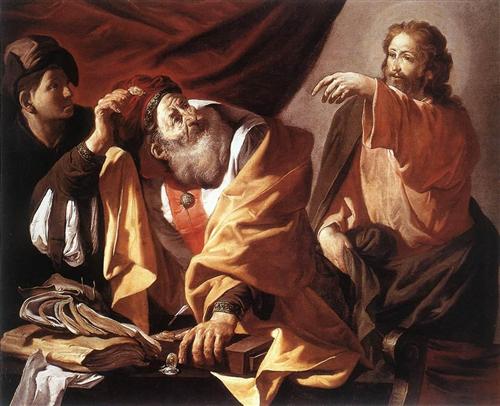,-The.jpg)
The Good Samaritan: Was this a parable about “inclusion?”
Most people know the Parable of the Good Samaritan. And most such people naturally assume that a “good Samaritan” has always been a person who “selflessly helps others.” (See Urban Dictionary: Good Samaritan: “Today a Good Samaritan is usually someone who goes out on a limb to help others, even if they are complete strangers.”)
 But most people don’t know that calling someone a “Samaritan” in the time of Jesus was pretty much like calling him a “Communist” – or worse – in the America of the 1950s:
But most people don’t know that calling someone a “Samaritan” in the time of Jesus was pretty much like calling him a “Communist” – or worse – in the America of the 1950s:
Portraying a Samaritan in a positive light would have come as a shock to Jesus’s audience. It is typical of his provocative speech in which conventional expectations are inverted… Jesus’ target audience, the Jews, hated Samaritans… The Samaritans in turn hated the Jews. Tensions were particularly high in the early decades of the 1st century because Samaritans had desecrated the Jewish Temple at Passover with human bones. (E.A.)
See Wikipedia. So the Jews hated the Samaritans and the Samaritans hated the Jews. (Sound familiar?) Or as Asimov put it (523), these were the “hated and heretical Samaritans.”
I bring all this up because the Daily Office Reading for Monday, September 28, 2015 – the Old Testament reading – described the root of why Jews hated Samaritans so much. (And by extension, why it was so provocative of Jesus to make a Samaritan a “hero” in His parable…)
But back to the root of the hatred itself.
The article Samaritans – Second-Class Citizens noted that “even worse than publicans* in the estimation of the Jews were the Samaritans… ‘Thou art a Samaritan and hast a devil’ was the mode in which the Jews expressed themselves when at a loss for a bitter reproach.”
For starters, in Matthew 10:5–6, Jesus told His disciples: “Do not go among the Gentiles or enter any town of the Samaritans.” (E.A.) And sometimes other Jews hurled this epithet – at Jesus – as noted above. See John 8:48: “The people retorted, “You Samaritan devil! Didn’t we say all along that you were possessed by a demon?” (In the New Living Translation.)
The sentence [- “you’re a Samaritan!” -] is singularly insulting in its tone and form. We cannot measure the exact amount of insult they condensed into this word, whether it be of heresy, or alienation from Israel, or accusation of impure descent.
(Emphasis added.) All of which is another way of saying there’s more to this parable than meets the eye. (The business of “impure descent” – illegitimacy – is a whole ‘nother subject…)
But getting back to that Old Testament Daily Office Reading for Monday, September 28. As noted, it goes back to why the Jews hated Samaritans so much.
 The story goes back to the time of Sargon II, and the year 722 B.C.:
The story goes back to the time of Sargon II, and the year 722 B.C.:
Under his rule, the Assyrians completed the defeat of the Kingdom of Israel, capturing Samaria after a siege of three years and exiling the inhabitants. This became the basis of the legends of the Lost Ten Tribes. According to the Bible, other people were brought to Samaria, the Samaritans… Sargon’s name actually appears [at] at Isaiah 20:1…
As Asimov explained it, in the year 725 B.C. the Hebrews – a “stubborn and stiff-necked people” – had rebelled once again against their overlords. (The Hebrew homeland got conquered quite often in Jewish history.) But in a twist, when Sargon conquered the northern Kingdom of Israel, he didn’t massacre the inhabitants wholesale. Instead he deported the native Hebrews and brought in new people – from far away – to colonize Samaria.
This tactic marked the permanent end of that northern Kingdom of Israel, and led to the story of the Ten Lost Tribes. Asimov estimated that some 27,000 “leading citizens” of Israel were deported; mostly landowners and members of the ruling class. the “colonists” were brought in from Babylon, some 500 miles away “as the crow flies.” Those new colonists centered in Samaria, and they and their descendants “are what the Bible refers to as Samaritans.”
Or as the Bible itself put it, in 2d Kings 17, verses 24-41 (“edited for content“):
The king of Assyria transported colonies of people from Babylon [and other areas] and resettled them in the cities of Samaria, replacing the people of Israel… But they continued to follow the religious customs of the nations from which they came. And this is still going on among them today… These colonists from Babylon worshiped the Lord, yes – but they also worshiped their idols. And to this day their descendants do the same thing.
For a contemporary equivalent, think of Northern Ireland and especially The Troubles. That article described the centuries-old conflict between Catholics and Protestants in Northern Ireland.
The “Troubles” started 500 years ago, in 1609: “In 1609, Scottish and English settlers, known as planters, were given land confiscated from the native Irish in the Plantation of Ulster. Coupled with Protestant immigration to ‘unplanted’ areas … this resulted in conflict between the native Catholics and the ‘planters,’ leading in turn to two bloody ethno-religious conflicts.”
And the two parties – Catholics and Protestants – both claimed to be “the true Israel” – in their own way – and that their version of Bible worship followed “the original” more closely, and that their enemies worshiped a “falsified text,” as noted below.
And to paraphrase 2d Kings 17:34, these Irish Troubles are “going on among them today.” (Or at least until the 1990s, after 30 years of “intense violence during which 3,254 people were killed.”)
But getting back to the root of Jewish hatred of Samaritans: When they came in to colonize the area, these “Neo-Samaritans” decided to worship both the God of the Hebrews, and also “their own gods.” (See also “hedging your bets.”) The resulting Samaritan religion became – in the eyes of native Hebrews – “a kind of Yahvistic heresy.” In turn the native Judeans would be “more hostile at times to the heretics than to the outright pagan.”
(As Asimov also noted, this too is a recurring phenomenon throughout history.)
Thus again, to the audience Jesus spoke to, these were the “hated and heretical Samaritans.” But the Samaritans in turn thought the same thing of the hostile Hebrews:
The Samaritans claimed that they were the true Israel[, and] that their version of the Pentateuch was the original and that the Jews had a falsified text… Both Jewish and Samaritan religious leaders taught that it was wrong to have any contact with the opposite group, and neither was to enter each other’s territories or even to speak to one another. During the New Testament period … Josephus reports numerous violent confrontations between Jews and Samaritans throughout the first half of the first century.
 See Samaritans – Wikipedia, which included the image at right: “Israeli actress from the Samaritan community, Sofi Tzadka… Born as an Israeli Samaritan, along with her siblings [she] formally converted to Judaism at the age of 18.” (She also did the voice-over role of “Ella of Frell (played by Anne Hathaway) in the Hebrew dub of the film ‘Ella Enchanted.'”)
See Samaritans – Wikipedia, which included the image at right: “Israeli actress from the Samaritan community, Sofi Tzadka… Born as an Israeli Samaritan, along with her siblings [she] formally converted to Judaism at the age of 18.” (She also did the voice-over role of “Ella of Frell (played by Anne Hathaway) in the Hebrew dub of the film ‘Ella Enchanted.'”)
I suppose there’s some kind of object lesson in Sofi’s example. (Perhaps on the healing power of beauty.) But we were talking about Jewish attitudes toward Samaritans in the time of Jesus.
Jesus clearly wanted to make a point by making the hero of this parable a Samaritan. The question is: What was His point? According to Asimov: “The point Jesus was making was that even a Samaritan could be a neighbor; how much more so, anyone else.” Thus to repeat:
The term “good Samaritan” has been used so often … that one gets the feeling that Samaritans were particularly good people and that it was only to be expected that a Samaritan would help someone in trouble. This loses the point of the story, since to a Jew at the time of Jesus, Samaritans were a hateful and despised people. (E.A.)
And again, there were at least two reasons why the Samaritans were so hated and despised. Not only did they usurp and colonize territory that had once belonged to the Kingdom of Israel, they had also usurped the Jewish religion itself. But they didn’t adopt the Jewish faith whole cloth. Instead – in the eyes of native Jews – the Samaritans had created a hybrid, “hedge-your-bets” and/or “feel good” type of religion that was tantamount to heresy.
 And the usual fate of heretics was to be massacred, as shown at left.
And the usual fate of heretics was to be massacred, as shown at left.
But Jesus didn’t want that. In His parable, first a priest and then a Levite passed by the fellow Hebrew who’d been beaten and robbed. “They were each learned in the law and undoubtedly knew the verse in Leviticus” – Leviticus 19:18, with its command to love your neighbor as yourself. “Yet they did nothing.” Instead, in this parable it was the hated and despised – infidel and heretic – Samaritan who helped.
Asimov said the “flavor of the parable” could be set in modern terms with a “white southern farmer left for dead,” but ignored and passed by by a minister and a sheriff. In this update of the parable, the white southern farmer would be saved by a “Negro sharecropper.”
In other words, a man is not a “neighbor” because of what he is but because of what he does. A goodhearted Samaritan is more the neighbor of a Jew, than a hardhearted fellow Jew. And, by extension, one might argue that the parable teaches that all men are neighbors, since all men could do well and have compassion, regardless of nationality. To love one’s neighbor is to love all men… The point Jesus was making was that even a Samaritan could be a neighbor; how much more so, anyone else.
And finally, Asimov noted that only the Gospel of Luke included this parable, which is “among the most popular of all those attributed to Jesus, and which preaches universalism.”
So I suppose you could say this parable was “about ‘inclusion.'” Which in turn is another way of saying that Jesus will never turn away anyone who comes to Him, as noted in John 6:37.
And besides all that, Luke seems to have been a pretty dang good artist…
“Luke paints the Madonna and the Baby Jesus…”
The upper image is courtesy of The Good Samaritan (after Delacroix), by Vincent Van Gogh.
Re: “Inclusion.” The practice where “different groups or individuals having different backgrounds like origin, age, race and ethnicity, religion, gender, sexual orientation and gender identity and other are culturally and socially accepted and welcomed, equally treated, etc.”
On that note, see Paul Ryan urges GOP, from August 2014: “Republican congressman and 2012 vice presidential candidate Paul Ryan … says his party is doomed to future defeats unless it broadens its appeal beyond a traditional base of older white voters… Ryan says his party needs to be more inclusive, spend far more time talking to black and Latino voters, and avoid playing into what he calls a caricature of the ‘cold-hearted Republican.'” Then there’s Some black conservatives question tea party’s inclusiveness. (So apparently “inclusiveness” is a good thing, to most people…)
For a further explanation of the Daily Office, see What’s a DOR?
Re: Isaac Asimov. The quotes about the Samaritans are from Asimov’s Guide to the Bible (Two Volumes in One), Avenel Books (1981), at pages 377-382, and pages 943-45. The quote about the “hated and heretical” Samaritans is from page 523.
Asimov (1920-1992) was “an American author and professor of biochemistry at Boston University, best known for his works of science fiction and for his popular science books. Asimov was one of the most prolific writers of all time, having written or edited more than 500 books and an estimated 90,000 letters and postcards.” His list of books included those on “astronomy, mathematics, theBible,William Shakespeare’s writing, and chemistry.” He was a long-time member of Mensa, “albeit reluctantly; he described some members of that organization as ‘brain-proud and aggressive about their IQs.’” See also Isaac Asimov – Wikipedia.
Re: “Publicans.” For more on how much the Jewish people of Jesus’ time hated publicans and tax collectors, see On St. Matthew: “No tax collector [at that time was] actually going to be loved, but a ‘publican’ of the Roman sort was sure to be hated above all men as a merciless leech who would take the shirt off a dying child.”
Re: distance from Babylon to Samaria. Google Maps puts the driving distance at some 2,600 miles, by a circuitous route including a ferry, tolls, restricted roads and “multiple countries.”
The “massacre” image is courtesy of the Wikipedia Heresy article. The caption: “Massacre of the Waldensians of Mérindol in 1545.”
The bottom “Luke paints” image is courtesy of Luke the Evangelist – Wikipedia. The full caption: “Luke paints the Madonna and the Baby Jesus, by Maarten van Heemskerck.” On that note:
Christian tradition, starting from the 8th century, states that he was the first icon painter. He is said to have painted pictures of the Virgin Mary and Child… He was also said to have painted Saints Peter and Paul, and to have illustrated a gospel book with a full cycle of miniatures.
The other Daily Office Readings for Monday, September 28, are Psalm 89:1-18, Psalm 89:19-52, 1st Corinthians 7:25-31, and Matthew 6:25-34.


 But the issue here is whether today’s Gospel tends to prove that Jesus was either a Conservative or a Liberal.
But the issue here is whether today’s Gospel tends to prove that Jesus was either a Conservative or a Liberal. In still further words, Jesus seemed to be showing that He was a true
In still further words, Jesus seemed to be showing that He was a true  But in the reading for September 27, Haman’s plans come unraveled. (As shown metaphorically at left.)
But in the reading for September 27, Haman’s plans come unraveled. (As shown metaphorically at left.)

 But
But  Meanwhile, back to St. Matthew. (See
Meanwhile, back to St. Matthew. (See  Asimov noted that Matthew’s name came from the Hebrew meaning “gift of God,” and that it was a common name in New Testament times. This was due in large part to “the great pride of the Jews in the achievements of priest
Asimov noted that Matthew’s name came from the Hebrew meaning “gift of God,” and that it was a common name in New Testament times. This was due in large part to “the great pride of the Jews in the achievements of priest  Another interpretation of Jesus “calling” Matthew…
Another interpretation of Jesus “calling” Matthew…
 The readings for August 15 – the day that my brother and I launched our canoe from
The readings for August 15 – the day that my brother and I launched our canoe from  The Gospel for August 17 featured Jesus
The Gospel for August 17 featured Jesus  The Gospel for August 27 was
The Gospel for August 27 was 